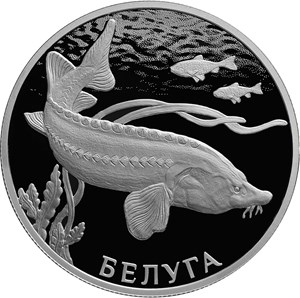Beluga
Obverse
the mirror field of the disc bears a relief image of the National Coat of Arms of the Russian Federation, over it along the rim there is the semicircular inscription "РОССИЙСКАЯ ФЕДЕРАЦИЯ" (RUSSIAN FEDERATION) framed on both sides by doubled rhombuses, below under the coat of arms there are indications of the precious metal and its fineness on the left and the fine metal content and the mint trade mark on the right, at the bottom in the centre, in three lines, there is an inscription "БАНК РОССИИ" (BANK OF RUSSIA), the denomination of the coin "2 РУБЛЯ" (2 RUBLES), and the year of issue "2019 г." (2019).
Reverse
the mirror field of the disc bears a relief image of beluga; at the bottom there is a semicircular inscription: "БЕЛУГА" (BELUGA).
Authors
The artists: E.V. Kramskaya (obverse), F.S. Andronov (reverse).
The sculptors: A.A. Dolgopolova (obverse), F.S. Andronov (reverse).
Mint: Saint Petersburg Mint (СПМД).
The edge: 195 corrugations.
Discover more
Series: Red Data Book
Beluga
Catalogue number: 5110-0160
The beluga (Huso huso) is a fish in the sturgeon family. It is critically endangered.
Belugas used to be a valuable food fish. They are native to the Caspian, Azov, Black and Adriatic Sea basins. However, currently, the beluga’s natural spawning grounds only remained in the Caspian and Black Seas. The Adriatic population is considered to be extinct. There are no reliable information about beluga population in the Sea of Azov; however, the population is reportedly artificially reproduced at the present time. The main reasons behind a sharp reduction of beluga population is the loss of natural spawning grounds as a result of hydraulic structure construction, small spawning population, inefficient artificial reproduction because of the spawner insufficiency, and river and sea overfishing until the mid-1980s.
Since 1986, beluga fishing in the Sea of Azov has been banned, except for spawner fishing for artificial reproduction.
Source: http://www.mnr.gov.ru


